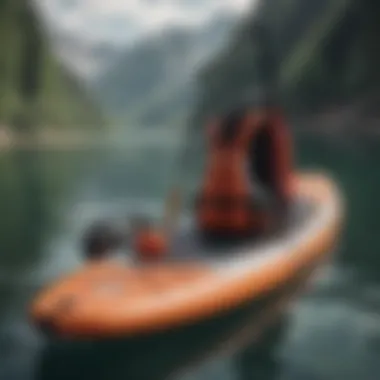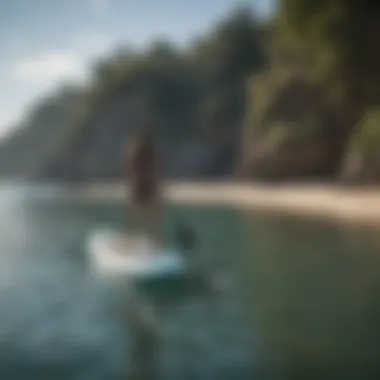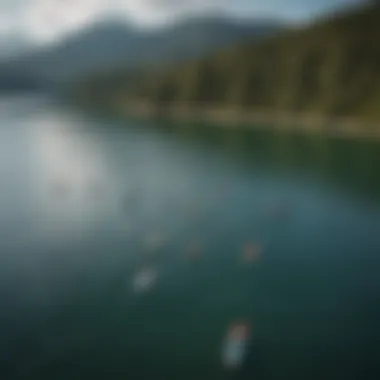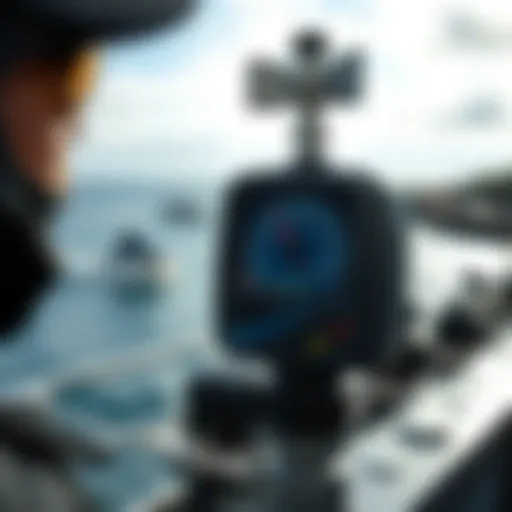Mastering Stand Up Paddleboarding: Techniques and Destinations


Intro
Stand up paddleboarding (SUP) has flourished into a favored watersport for many enthusiasts. It involves standing on a broad board and using a paddle to propel oneself across the water. This activity provided a sustainable way for people to enjoy water and connect with nature.
SUP's growth can be attributed to its versatility. Whether on calm lakes, serene rivers, or ocean waves, this sport welcomes people of all ages and skill levels. The appeal lies not only in the physical exercise it offers but also in the opportunity to be outdoors.
In this article, we will delve into the world of stand up paddleboarding. We will cover techniques for mastering the sport, essential gear to enhance the experience, and top destinations for paddleboarding. Our aim is to provide a complete guide for both beginners and experienced paddlers.
Water Activity Overview
Stand up paddleboarding is just one of several activities that people can enjoy in the water. Here is a brief overview of related activities to understand where SUP fits in.
Surfing
Surfing involves riding on waves using a surfboard. It requires balance and skill. Some SUP enthusiasts transition to surfing techniques when riding larger swells.
Sailing
Sailing utilizes wind power to move a boat across water. The techniques differ quite significantly from those used in paddleboarding, focusing more on navigation and wind patterns.
Snorkeling
Snorkeling allows individuals to explore underwater life while floating on the surface with a mask and snorkel. Although this activity is less commonly combined with paddleboarding, some paddlers may stop to snorkel at interesting spots.
Paddleboarding
Stand up paddleboarding rests on a foundation of balance and coordination. Unlike surfing or sailing, SUP does not require large waves or wind. The sport emphasizes stability and technique, making it accessible.
Tips and Techniques
To enhance your paddleboarding experience, understanding various techniques and tips is crucial.
Tips for beginners
- Start on calm water: Begin your journey in a quiet lake or flat area. This minimizes the chances of falling and builds confidence.
- Focus on posture: Keep your feet shoulder-width apart and slightly bend your knees. This position aids balance.
- Paddle correctly: Alternate paddling on both sides to maintain a straight path. Varying your strokes can help control direction.
Advanced techniques for experienced enthusiasts
- Turning effectively: To pivot quickly, shift your weight back while paddling deep on the opposite side of the board.
- Surfing waves: For experienced paddlers, catching waves involves reading the water and timing your entry.
Safety guidelines
- Wear a personal flotation device (PFD): Always use a proper PFD, especially in crowded or unpredictable waters.
- Check the weather conditions: Monitor wind and tide forecasts before going out.
- Stay aware of surroundings: Be vigilant about other boats, swimmers, and local wildlife.
Gear Reviews
Selecting proper gear is fundamental to a successful paddleboarding experience.
Paddleboards
Different types of paddleboards exist. For instance, inflatable paddleboards are portable and easy to store, while hardboards typically offer stiffness and speed.
Wetsuits
Wetsuits are vital for colder water. They help retain body heat and protect the skin. Choose the thickness based on water temperature.
Additional gear considerations
Consider investing in a quality paddle, leash, and safety flotation devices.
Destination Guides
Choosing where to paddle can make all the difference in your experience. Here are some popular destinations:
Popular water sports locations
- Lake Tahoe, California: Known for its clear water and beautiful setting, it's great for paddlers at all levels.
- Key West, Florida: A tropical paradise with calm waters and stunning scenery.
Hidden gems for water enthusiasts
- Dojran Lake, Macedonia: A serene spot that offers beautiful landscapes and fewer crowds.
- The Pigeon Lake, Canada: Offers a quiet escape surrounded by nature.
Travel tips for water sports trips


- Plan accommodation near the water: Staying close can save time and increase your time on the water.
- Research local rentals: If you don’t have your gear, check local shops for rentals.
Paddleboarding is not just a sport; it's a way to connect with nature and enjoy the outdoors.
This exploration of stand up paddleboarding provides a roadmap for those seeking to engage with the sport. From techniques to destinations, a thoughtful approach can enhance both skill and enjoyment in paddleboarding outings.
Prologue to Stand Up Paddleboarding
Stand up paddleboarding, often referred to as SUP, has gained immense popularity as a versatile water sport. It presents opportunities for recreation, fitness, and exploration, making it an appealing choice for people of all ages and skill levels. Understanding the fundamentals of this sport is essential for both beginners and seasoned practitioners alike. The article aims to delve into various aspects of stand up paddleboarding, including techniques, gear selection, and ideal destinations.
Definition and Overview
Stand up paddleboarding involves propelling oneself across water on a large board while using a paddle. This sport is unique as it combines elements of surfing, kayaking, and traditional paddling into one engaging experience. Participants stand upright on the board, maintaining balance while navigating through still waters or waves. SUP provides an excellent full-body workout, fostering strength and stability. In addition to physical benefits, this activity promotes mental well-being, as it allows participants to connect with nature and enjoy the tranquility of their surroundings.
History and Evolution of SUP
The origins of stand up paddleboarding trace back to ancient cultures. Early variations of SUP have been found in Polynesia, where indigenous peoples used similar techniques for fishing and transportation. However, the modern version of the sport emerged in the late 20th century in Hawaii. Surf instructors in the 1940s began using paddles to maintain better control while teaching surfing.
Since then, the sport has evolved significantly, influenced by advancements in board design and materials. Initially, paddleboards were heavy and cumbersome, often made from wood. Today's options include lightweight materials such as foam and carbon fiber, resulting in boards that are more efficient for various conditions. SUP has seen rapid growth, leading to innovations in gear and a greater emphasis on environmental awareness within the paddling community.
"Stand up paddleboarding merges fitness, adventure, and serenity, drawing thousands to its shores each year."
As the sport continues to develop, it remains a key player in the water sports world, attracting enthusiasts from all walks of life. The fusion of physical challenge and scenic exploration contributes to its enduring appeal, making stand up paddleboarding a staple activity for those looking to embrace an active lifestyle.
The Mechanics of Paddleboarding
Understanding the mechanics of paddleboarding is essential for both beginners and seasoned enthusiasts. This knowledge equips paddlers with the skills to navigate water more efficiently, ensuring an enjoyable and safe experience. Mechanics involves various components, including board dynamics, paddling techniques, balance, and stance. Each of these elements contributes significantly to overall performance on the water.
Understanding Board Dynamics
The performance of a paddleboard hinges on its design. Board dynamics refer to how a paddleboard interacts with water, including factors like buoyancy, volume, and shape. A board’s shape dictates its speed and stability; wider boards offer better stability, while narrower options favor speed. Different conditions affect how boards behave, and recognizing these nuances can greatly enhance a paddler’s skill.
Some significant characteristics to consider are:
- Volume: This is critical for stability. Higher volume boards can carry more weight and are generally more stable.
- Length: Longer boards glide smoother over water, while shorter boards are more maneuverable.
- Rocker: The degree of curved shape from the nose to the tail influences how well the board moves through different water conditions.
The right board dynamics can make or break your paddleboarding experience. Understanding these aspects is not merely academic; it translates directly into improved performance and enjoyment.
Paddling Techniques Explained
Paddling is the primary means of propulsion on a paddleboard. Mastering paddling techniques is crucial for efficiency. A good technique maximizes forward momentum while minimizing fatigue. Basic paddling involves alternating strokes on each side of the board. Here are key paddling techniques:
- The Forward Stroke: Begin with a proper grip on the paddle, submerge the blade deeply, and pull the paddle back in a clean, straight line.
- The Sweep Stroke: Useful for turning, this stroke involves a wide arc away from the board's side.
- The Back Stroke: For reversing or slowing down, pull the paddle back, similar to the forward stroke but in reverse.
Consistent practice of these techniques will lead to more fluid motion and improved control over the board.
Balance and Stance
Maintaining balance is fundamental to paddleboarding. A stable stance minimizes the risk of falling and allows paddlers to navigate choppy waters more confidently. Key points for achieving balance include:
- Feet Placement: Position your feet shoulder-width apart, ensuring each foot is centered over the rails of the board.
- Knees Slightly Bent: Keeping knees bent will provide greater stability and flexibility to adjust to the board's movements.
- Engage Your Core: Activating core muscles helps in maintaining a solid base, thus preventing excessive swaying.
Overall, balance and stance are crucial for performance. Regularly practicing techniques will promote adaptability and comfort on the water.
In this section, the intricate mechanics of paddleboarding demonstrate how deeply connected each aspect is in contributing to a successful and enjoyable paddling experience.
Choosing the Right Gear
Choosing the right gear is crucial in stand up paddleboarding (SUP). It directly impacts your overall experience and performance on the water. The right equipment enhances stability, speed, and comfort, which are vital for both beginners and advanced paddlers. When selecting gear, various factors come into play, including personal preferences, intended use, and skill level. Understanding these elements helps in making informed choices, ultimately leading to more enjoyable and effective paddleboarding sessions.
Types of Paddleboards
All-Around Boards
All-around boards serve as versatile options for paddlers of all skill levels. Their design allows for use in various water conditions, making them a top choice for recreational paddling. A key characteristic of all-around boards is their wide and stable shape, which assists beginners in maintaining balance.
The unique feature of these boards is the combination of stability and maneuverability. The advantages include accessibility for inexperienced paddlers and suitability for a variety of activities. However, they may not offer the same speed as specialized boards, which can be a limitation for those looking to race or cover long distances.
Touring Boards
Touring boards are crafted specifically for longer distances and open water conditions. Their shape is sleeker compared to all-around models, providing improved glide and speed. This type of board is advantageous for those seeking to explore lakes and coastal areas.
Touring boards typically feature a longer and narrower build, which aids in tracking straight paths over distances. The benefits of these boards include increased efficiency in paddling and the ability to carry gear. The drawback is that they may be less stable for beginners, requiring a bit more skill to use effectively.
Race Boards


Race boards focus on maximizing speed and performance in competitive settings. These boards are long, narrow, and designed for minimal drag in the water. Their key characteristic makes them ideal for serious racers and those who wish to participate in competitions.
The unique feature of race boards is their lightweight construction and streamlined shape, which provides exceptional speed. The advantages lie in their performance in races and fast paddling sessions. However, their narrow design can limit stability, making them less suitable for casual paddlers or beginners who may find them challenging to balance on.
Fishing Boards
Fishing boards cater to enthusiasts who want to combine paddleboarding with fishing. These boards are typically wider and more stable to accommodate gear and the angler's movements. A key characteristic is the added space for fishing equipment and often built-in rod holders.
The unique aspect of fishing boards is their stability and utility for anglers. The advantages include a more enjoyable fishing experience with the ability to reach remote areas. However, they may not perform as well in racing or long-distance paddling due to their bulkier design.
Essential Accessories
Paddles
Paddles play a vital role in the paddleboarding experience. A key characteristic of paddles is their design, which can influence paddling efficiency. Paddles are generally adjustable in length, allowing for a customized fit depending on the paddler's height.
The unique feature of a quality paddle is its weight and material, typically lightweight either in aluminum or carbon for ease of use. The advantages include improved performance and reducing fatigue during long outings. A disadvantage may be the cost, as higher-quality paddles can be more expensive.
Leashes
Leashes are necessary for safety and keeping the board close. A proper leash secures the board to the paddler, preventing it from drifting away after falling into the water. A key characteristic of leashes is their length and material, ensuring they are durable enough to withstand the impact.
The unique feature is their elastic nature, which provides some give to prevent injury while still securing the board. Advantages include enhanced safety and control during use. The disadvantage is that forgetting to attach it can lead to losing the board in open water, which presents a risk.
Personal Floatation Devices
Personal flotation devices (PFDs) are essential for ensuring a safe paddleboarding experience. A key characteristic is their buoyancy, which offers support should a paddler fall overboard. They are available in various styles, with some designed for comfort and mobility.
The unique feature of PFDs is their designs that accommodate movement, allowing for paddling without restriction. Advantages include increased safety and compliance with regulations in certain areas. A disadvantage might be discomfort during hot days, as some models can be bulky or warm.
Maintenance and Care for Equipment
Proper maintenance and care for equipment extend its lifespan and enhance performance. Regular checks for wear and tear on boards and paddles ensure they remain in top condition. Cleaning boards after use prevents damage from saltwater or dirt.
Storing boards in a cool, dry place away from direct sunlight helps maintain structural integrity. Leashes and paddles should be inspected routinely for frays or breaks. Understanding how to care for your gear ensures a safe and enjoyable paddleboarding experience.
Techniques for Improvement
Improving paddleboarding techniques is essential for both pleasure and safety on the water. Enhanced skills contribute to better performance, allowing paddlers to navigate challenging waters confidently. Focusing on improving technique can also prevent injuries, making the experience more enjoyable overall. Understanding the fundamentals will ensure that the practice becomes second nature, whether you are a novice or someone with extensive experience.
Drills for Beginners
For those new to stand up paddleboarding, drills are vital to establish a solid foundation. The right drills enhance balance, coordination, and paddling efficiency. Here are some key exercises:
- Stance Balance Drill: Stand on your board in shallow water. Focus on bending your knees slightly and keeping your feet shoulder-width apart. This helps stabilize your core.
- Forward Paddling Drill: Practice paddling on one side for a set distance, and then switch sides. This exercise promotes equal strength on both sides of your body.
- Turning Drill: Use a pivot turn to practice steering. Paddle deeply on one side and step back slightly. This will improve your directional control without losing balance.
Regularly practicing these drills will enable beginners to develop effective habits and techniques, ensuring a safer and more pleasurable paddleboarding experience.
Advanced Techniques for Experienced Paddlers
For more seasoned paddlers, refining advanced techniques can lead to better performance in various conditions. Advanced skills may include:
- Cross Stepping: This technique involves moving your feet toward the tail of the board for sharper turns. It requires balance and agility.
- Downwind Paddling: Understanding how to use wind currents can greatly enhance speed. Learn to angle your board appropriately to benefit from tailwinds.
- Race Techniques: For those interested in competitive paddling, mastering stroke length and cadence is crucial. Incorporate interval training to improve speed and endurance.
These advanced techniques not only elevate the paddling experience but also make it more effective, particularly in varying conditions and competitive scenarios.
Safety Practices
Safety should always be a priority when paddleboarding. A few standard practices help ensure a safe outing:
- Always Wear a Personal Floatation Device (PFD): Regardless of your swimming ability, a PFD can save your life in emergencies.
- Check Weather Conditions: Before setting out, always monitor local weather. Changes can impact water safety dramatically, and high winds or stormy weather can create hazardous conditions.
- Buddy System: Paddle with a partner when possible. This enables quicker response times in case of accidents or emergencies.
- Know Your Limits: Understand your skill level and do not push beyond it. This is especially true in unfamiliar waters.
"Preparation is key for a safe paddleboarding experience."
By adhering to these practices, you can help ensure not just your safety, but also the safety of others on the water.
Understanding these techniques for improvement will greatly enhance your paddleboarding journey, making it safer and more enjoyable.
Popular Paddleboarding Destinations
Exploring popular paddleboarding destinations is crucial for enthusiasts looking to enhance their experience. Whether you are a beginner eager to learn or a seasoned paddler wanting to discover new challenges, the right location matters. Each destination can offer unique scenery, varying water conditions, and access to essential amenities. These factors can significantly affect your overall enjoyment and skill development.
Coastal Locations
Coastal areas provide a range of opportunities for paddleboarding. These locations often feature diverse marine environments, including bays, estuaries, and open ocean waters. Paddling along coastlines can immerse you in stunning natural beauty while offering excellent visibility of marine life. Places like Monterey Bay in California or the Florida Keys are renowned for their clear waters and rich ecosystems.


Benefits of coastal paddling include:
- Access to waves: For those interested in surfing or improving their balance.
- Wildlife spotting: A chance to see dolphins, turtles, and various fish species.
- Scenic views: Coastal geography often presents breathtaking sunsets and landscapes.
However, paddlers should consider the fluctuating tides and winds typical of coastal environments. Plan trips carefully to ensure safety and choose appropriate times for your skill level.
Lake Paddleboarding Hotspots
Lakes are an ideal choice for those who prefer calmer waters. These spots often cater to beginners and families, allowing for relaxed paddling without the unpredictability of ocean waves. Lakes like Lake Tahoe or Flathead Lake showcase serene conditions and beautiful backdrops, ideal for leisurely outings or practicing techniques.
A few considerations when choosing a lake destination include:
- Water clarity: Crystal clear lakes enhance the visual experience and allow insight into underwater life.
- Surrounding amenities: Many lakes have nearby accommodations and supplies, which facilitate longer trips.
- Safety measures: Even in calm waters, always wear a personal floatation device and check local regulations.
International Paddleboarding Locations
For those looking to travel, international paddleboarding locations provide unique experiences that go beyond local waters. Exploring destinations like Bali, Indonesia, or the Mediterranean coast offers access to varied cultures and environments. Each place brings its own set of challenges and beauty, suited for both adventure seekers and leisure paddlers.
International spots can provide numerous advantages, such as:
- Cultural immersion: Experience local traditions and ways of life.
- Diverse conditions: Paddling in different water types from calm lagoons to energetic wave breaks.
- Global community: Connect with other paddlers from around the world, expanding your network and expertise.
Paddleboarding in exotic locations may require additional planning, especially concerning equipment rentals and suitability for your skill level. Always research areas beforehand and consult with local guides to ensure a fulfilling experience.
"Choosing the right location can transform a paddleboarding trip into a memorable adventure.\n Consider your skill level, preferences, and local conditions."
The Community and Culture of SUP
The community and culture of Stand Up Paddleboarding (SUP) play a crucial role in enriching the experience of this sport. As it has gained popularity, it has also fostered a sense of camaraderie among enthusiasts. This community aspect offers various benefits and creates deeper connections among paddlers, enhancing their relationship with the sport. Many might find it unassuming, but the communal nature of SUP provides vital support for both novices and seasoned paddlers.
Events and Competitions
Paddleboarding events are more than just competitions; they are celebrations of the sport and its community. These gatherings bring together participants from different backgrounds, allowing them to showcase their skills, share experiences, and learn from one another. Events such as the SUP World Championship or local races provide a platform for competition but also an opportunity for social interaction.
These events often feature multiple categories, including fun races for recreational paddlers, technical courses for the more advanced, and even distance races. Competing can enhance one’s skills and offer valuable feedback from peers. Of course, it also promotes local economies as hosts attract visitors who might not otherwise explore these regions.
Moreover, these competitions tend to feature a vibrant atmosphere, with vendors providing gear, food, and other services. If you are interested in joining an event, it is beneficial to check platforms like Reddit for local announcements, which often share firsthand experiences from paddlers.
Environmental Considerations
As the community of paddleboarders grows, so does the responsibility to protect our waterways. Environmental considerations are vital within the SUP culture. Many paddleboarding communities are actively engaged in preserving the natural habitats they enjoy. This includes organizing clean-up events and awareness campaigns that focus on the importance of maintaining clean waters.
Paddlers have potent access to beaches, lakes, and rivers and this makes them frontline advocates for environmental stewardship. Emphasizing sustainable practices, such as reducing plastic use and respecting wildlife, is often discussed within community circles. The hope is that these actions will inspire others who enjoy similar activities to also take care of the environment.
The Future of Stand Up Paddleboarding
The future of stand up paddleboarding (SUP) is pivotal for both enthusiasts and the broader water sports community. New trends and technological advancements are shaping how people approach this activity. Understanding these developments offers valuable insights that can enhance the sport and its accessibility.
Emerging Trends in the Sport
The landscape of paddleboarding is evolving. Here are some notable trends:
- Growth in Eco-Conscious Practices: Many paddlers are now more aware of their environmental impact. This has led to increased interest in eco-friendly boards made from sustainable materials.
- Fitness and Wellness Integration: SUP has gained traction in wellness communities. Activities like paddleboard yoga have emerged, attracting those seeking alternative fitness routines. This integration reflects a growing desire for both physical fitness and mindfulness.
- Advent of Group Paddleboarding: Group outings have become popular. Social gatherings on the water promote community engagement. Paddleboarding clubs and organized events encourage participation and foster friendships.
- Diverse Demographics: Paddleboarding is attracting a varied audience. From families to retirees, the sport serves all ages and abilities. This inclusiveness enhances its appeal as a recreational activity.
Technological Innovations
Technology plays a significant role in transforming paddleboarding. Innovations include:
- Improved Board Materials: Developments in materials science have resulted in lighter and more durable boards. Carbon fiber and advanced plastics are becoming popular choices.
- Smart Gadgets: Wearable technology can now track paddling efficiency and distance. Some devices even integrate GPS and heart rate monitoring, enhancing the paddler’s experience and performance.
- Electric Paddleboards: These boards allow users to enjoy the sport with less physical exertion. They open up paddleboarding to those who may struggle with traditional paddling.
- Online Communities and Resources: The rise of social media platforms enables paddlers to share experiences and techniques. Virtual workshops can also enrich learning and provide support for both beginners and seasoned paddleboarders.
By embracing these emerging trends and technological innovations, the future of stand up paddleboarding looks promising. The sport is set to reach greater heights, attracting new participants and inspiring a culture of inclusivity.
Finale
In summary, the conclusion serves as a critical capstone to our comprehensive exploration of stand up paddleboarding. At this point, it is vital to recognize the multifaceted nature of the sport. We have examined its historical development, the mechanics that govern paddleboarding, the essential gear required, and the diverse array of locations suited for both leisurely paddleboarding and more intense experiences.
Recap of Key Points
- Historical Context: A brief look at how stand up paddleboarding evolved over the years, reflecting the growing popularity of the sport across different cultures.
- Mechanics of Paddleboarding: Understanding the dynamics of board movement, proper paddling techniques, and the significance of maintaining balance and stance.
- Gear Selection: Insight into various paddleboard types such as all-around boards and racing boards, as well as the importance of accessories like paddles and leashes.
- Improvement Techniques: Skills enhancement strategies ranging from beginner drills to advanced paddling techniques that ensure safety and efficiency on water.
- Popular Destinations: An overview of some of the most appealing locations globally, whether it be in coastal regions, serene lakes, or iconic international spots.
- Community and Culture: Exploration of events, competitions, and environmental considerations highlighting the social aspect of the sport.
- Future Trends: Awareness of emerging trends and technological innovations that may shape the future of stand up paddleboarding.
Recapping these key elements elucidates the breadth of the subject and emphasizes its relevance in today's active lifestyles. Paddleboarding combines physical activity with leisure, engaging not only the body but also fostering a greater appreciation for nature and community interaction.
Encouragement for Further Exploration
The journey does not end here. Engaging with the world of stand up paddleboarding invites continual learning and exploration. It is encouraged to seek experiences beyond the known. Consider:
- Joining a local club: Participating in organized outings can deepen knowledge and skills while connecting with others passionate about paddleboarding.
- Attending workshops: Instructional settings may offer insights into advanced techniques or specialized areas such as SUP yoga or racing.
- Exploring diverse environments: Traveling to new locations can present unique challenges and beauty. Each body of water offers distinct experiences.
- Staying updated on trends: Following influential sites such as Reddit or specialized forums can provide valuable information and community support.
"The water is a welcoming yet challenging teacher. Approach it with respect and curiosity."
By embracing these opportunities for further exploration, enthusiasts can gain broader perspectives and continually refine their skills. Each outing on the water serves as a chance to connect with nature while promoting a lifestyle that values health and adventure.















